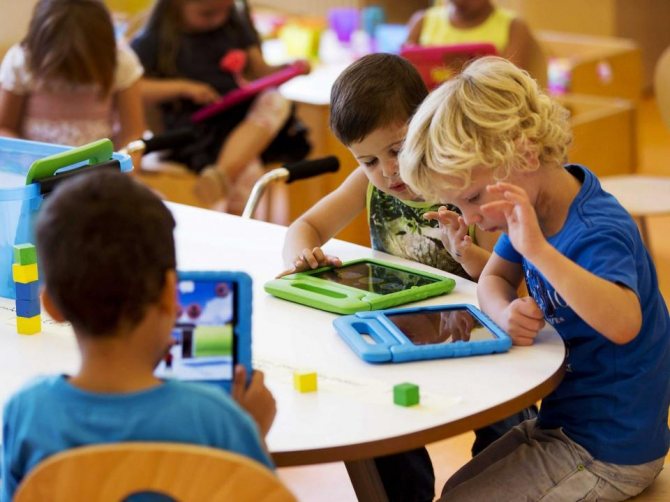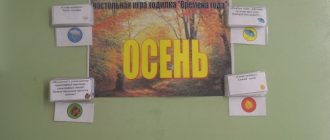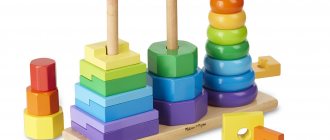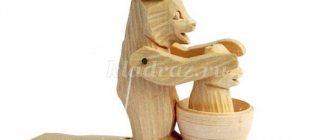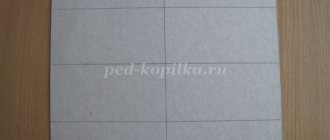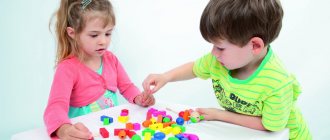Consultation “Didactic materials in the work of a preschool teacher”
Galia
Consultation “Didactic materials in the work of a preschool teacher”
Didactic materials in the work of a preschool teacher
“Leading activity is activity, the implementation of which determines the emergence and formation of the basic mental new formations of a person at a given stage of development of his personality.” [3]
L. S. Vygotsky laid the foundations for ideas about leading activity.
Further, the hypothesis about the leading type of activity was expressed in 1944-45. A. N. Leontiev and was developed in of D. B. Elkonina, V.V. Davydova and others, according to this hypothesis, leading activity is a criterion for the periodization of mental development, an indicator of the child’s psychological age. According to this periodization, the leading activity of preschool children is play.
“Game is the leading type of activity for a preschool child”
.
“Play is an activity in which a child first emotionally and then intellectually masters the entire system of human relationships. A game is a special form of mastering reality by reproducing and modeling it.” In order for the game to educate the child and bring positive emotions during the game, educators select and create special teaching aids . With the help of didactic games, children develop, educate and learn during their natural activities. [4]
To create such a game, didactic materials .
What is the importance of didactic material in kindergarten ?
According to the Federal State Educational Standard for Preschool Education, the developing subject-spatial environment in which children find themselves must, first of all, be content-rich. That is, the educational space must be equipped with means of training and education , appropriate materials ( didactic , including consumable gaming, sports, recreational equipment and inventory. In this context, properly selected didactic materials . They are the teacher’s assistants for the development of the child’s abilities and learning something new.Such materials should be aesthetically attractive, pleasant to the touch, colorful, bright to stimulate interest and attract the child’s attention.
What is didactic material ?
“ Didactic material is a special type of teaching aids, the use of which helps to enhance the cognitive activity of students and save learning time.” [2]
Didactic material , educational material - a type of visual teaching aids (maps, tables, reagents, plants, etc., distributed to students for independent work in class or at home or demonstrated by a teacher; didactic material is also called collections of tasks and exercises.
Didactic materials in preschool institutions are materials that are simple in content and aimed at learning through play, complement it and are used in the process of its implementation (educational games, various cards, drawings, diagrams, presentations)
.
What are didactic materials in the form of a game ? During the game, the child receives a variety of information and learns new skills and knowledge. Play is a part of a child’s life, but through the process of properly selected entertainment, the young explorer will learn. The game brings the child pleasure from the process itself; the result is not important for him. Every game has rules, and the child learns them, remembers them, and thereby learns.
During the game, the child acquires new knowledge and skills.
didactic materials should have : variability of forms and methods of presenting material ; focus on proactive learning; engaging content; focus on developing thinking abilities.
Purposes of using didactic materials :
development of fine motor skills and tactile sensitivity;
formation of ideas about the external properties of objects (shape, color, size, position in space)
;
creating a positive emotional mood;
development of cognitive processes (memory, attention, thinking)
;
development of speech skills;
teaching numeracy and literacy.
All didactic materials are divided into several types:
Subject-shaped manuals reveal the most general, essential characteristics of the objects being studied. Natural (made from natural materials )
and three-dimensional
didactic materials :
Natural visual aids are aids created from natural materials .
Three-dimensional didactic materials are manuals that clearly demonstrate the process or structure of the subject under discussion (models, layouts, dummies, etc.)
.
Iconic didactic materials - designed as material in pictures , handouts , demonstration material (stands, posters, multimedia presentations, etc.)
Figurative-symbolic visual aids are materials that allow children to remember the image of the object being studied as a whole and abstract from particulars (subject and subject pictures, various cards, portraits, applications, photos, films, etc.).
Conventionally symbolic didactic material is material that reveals or examines particulars or details according to one or more active characteristics.
didactic materials for kindergarten yourself. The process of creating manuals includes a number of stages:
Statement of the goal - what exactly the developed didactic material . The benefit must be age-appropriate , understandable and accessible.
Selecting a topic within which teaching material (for example, “Primary colors”
).
Think over the concept of the aid - what type of visual aid is being created: cards, a stand, a poster or an entire game.
Select suitable materials to create a visual aid - the material should be bright so that the child can easily remember what was depicted. The material should not be brittle or easily breakable. The material should be as safe as possible for preschoolers. The materials used must be hypoallergenic. The material must withstand sanitary treatment .
Assembling the material - the information depicted or presented must characterize the world around us and correspond to reality; the didactic material was beautifully and neatly designed.
Timely planning of the use of created didactic material .
The selection of didactic materials depends not only on the material equipment of the preschool educational institution , but also on the set goals of educational work , methods, age of the children, as well as on the characteristic features of individual educational educational institutions.
The use of didactic materials in kindergarten helps to develop the cognitive, communicative and creative abilities of preschoolers of all age groups. When applying benefits, the teacher should remember the wide range of choices for their presentation. Making didactic materials with your own hands allows you to implement various pedagogical ideas in the educational process of a preschool educational institution. The main thing is to correctly develop the manuals , think them through and arrange them. A variety of methodological recommendations and the author’s own imagination will help with this. [9]
Bibliography:
1. Kulikovskaya T. “ Didactic material “The World Around Us”, “Animals of the Arctic and Antarctic”
2. Moiseev V. B. Information technologies in the higher education system. - Penza, 2002. p. 94)
3. Popular psychological encyclopedia. — M.: Eksmo. S. S. Stepanov. 2005. (p. 102)
4. Professional education. Dictionary. Key concepts, term, current vocabulary. - M.: NMC SPO. S. M. Vishnyakova. 1999.
5. Psychological and pedagogical dictionary. / Comp. Rapatsevich E. S. – Minsk, 2006, p. 184-185.
6. The role of didactic materials in the learning process [access mode: https://letopisi.ru/index.php]
7. https://www.montessori-center.ru/kursy-i-seminary_744/didakticheskij-material/
8. https://info-4all.ru/obrazovanie/chto-takoe-didakticheskie-materiali/
9. https://melkie.net/metodicheskie-razrabotki/didakticheskiy-material-dlya-detskogo-sada-svoimi-rukami.html
10. https://psychlib.ru/mgppu/ode/ode-001.htm#$p193
Didactic games and teaching aids
“Match the lid to the box”
Goal: selection of items according to the sample.
Didactic material: boxes of different shapes (round, quadrangular, rectangular, triangular) and corresponding lids.
Methodological techniques: the teacher, holding the child’s hand, traces the shape of the box’s opening with his finger. Then he shows the object, accompanying the action with a word. In front of the children, he lowers the object into the corresponding hole. After that, he offers the children this task.
"Funny Clothespins"
Goal: to teach children to correctly take and open a clothespin, find its location by color.
Didactic material: a transparent container with colored stripes glued along the edge, a set of colored clothespins
Game “Name the properties of materials”
Goal: To learn to determine the names of various properties of a material, to establish relationships between the material and its sensation. Demonstration material for the game: samples of materials that feel different to the touch, sewn into squares of fabric that feels different to the touch. Let each child play with the squares and feel them. Talk with children about the different properties of materials: are they hard or soft, smooth or rough... When children remember their tactile sensations of different types of surfaces, mix up the squares and give each child one sample. Will they be able to find a match for this sample? Of course, children will be able to navigate not only with the help of tactile sensations, but also with the help of vision. But at the initial stage this will not hurt, as children will be able to gain confidence in their abilities. Then you can complicate the task. Let the children try to pick “doubles” blindly. In this case, they will navigate based entirely on tactile perception. When giving this task, ask the children to name the properties of materials: hard, soft, smooth, rough.
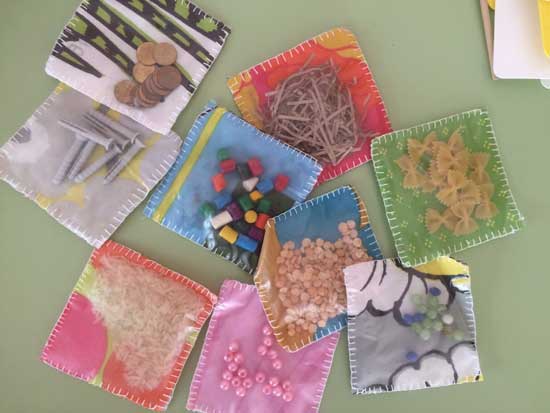
Didactic sensory game “Guess what’s making noise”
Sensory development (sensation, feeling) is aimed at the development of visual, auditory, tactile, kinetic and other types of sensations and perceptions. The diversity of his environment is of decisive importance in the cognitive development of a child. The child should be surrounded by toys made of different materials that move. Also toys that use different principles of sound production; homemade noisy, rattling, rustling objects . I present to your attention the game “ Noise Makers ”.
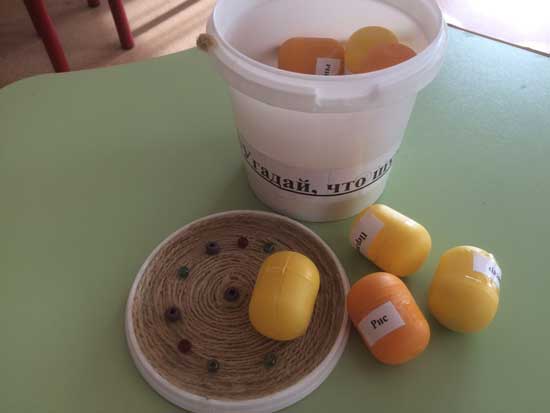
Didactic game “Magic shoes”, “Cheerful hedgehog”
Purpose of the game : To develop fine motor skills and teach the child to lace up shoes, insert them into their holes, and correctly fasten and unfasten buttons.
Objectives : To cultivate perseverance and determination; develop speech activity and attention; promote the development of logical thinking.
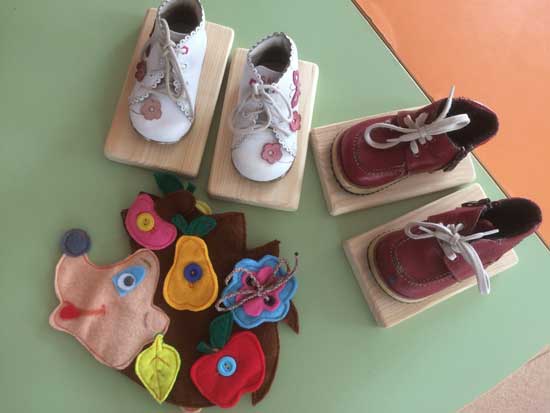
"Sponge stamps"
All-round creative development is useful and necessary for all children. But not all children like to draw , but the technique of drawing with stamps is liked by all children and even adults without exception. By drawing in this way, children are not afraid of making mistakes, since everything can be easily corrected, and something new can easily be invented from a mistake, and the child gains self-confidence, overcomes the “fear of a blank sheet of paper” and begins to feel like a little artist. He develops an INTEREST, and at the same time a DESIRE to draw . After all, you can print with anything. This is what real creativity will be.
In order for printing figures to acquire some meaning, invite your child to decorate a paper plate, a vase cut out of cardboard, or a painted doll’s . You can draw rowan berries and scarlet strawberries with foam rubber, beads on the girl’s neck and a bright rooster’s tail. The main thing is that the creative process is enjoyable and evokes an emotional response in the young artist.
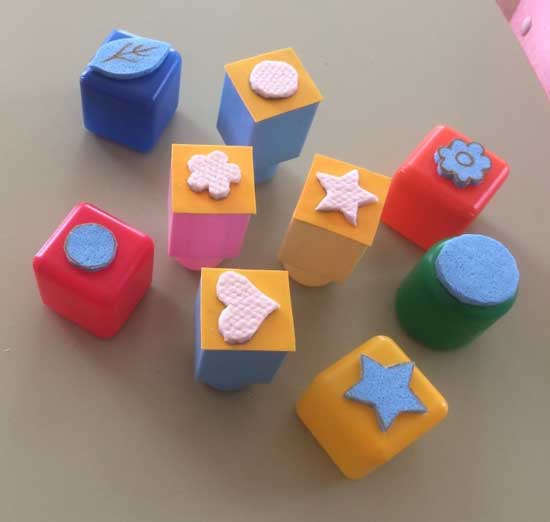
Do-it-yourself non-standard equipment for physical education classes in kindergarten made from waste material
Making non-standard equipment from waste material with your own hands for physical education and using it in classes and games Goal: To create interest in non-standard equipment, to involve teachers and parents in its production; develop creativity and imagination when using non-standard equipment; motivate children to be physically active through the use of non-standard equipment in independent activities.
Body massagers. Kinder massagers
Objectives: Strengthen the muscles of the back, chest and legs

"Basketball basket"
Goal: Throw the ball into the hoop. Develops dexterity and accuracy. The difficulty of the exercise is adjusted by the distance from the ring.
Organization: The bottom and top of a plastic bottle (5 l) are cut off. The edges of the bottle are tied with polypropylene thread
Use case: Who will score more points for each hit.
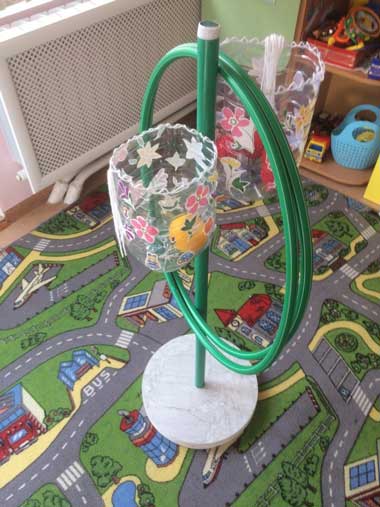
Busyboard - an entertaining educational board for children
A busy board (or development board) is a special invention of modern educators that allows you to achieve two goals at once: to reliably distract a child’s attention so that he does not engage in various stupid things, and at the same time develop his intelligence through play.\
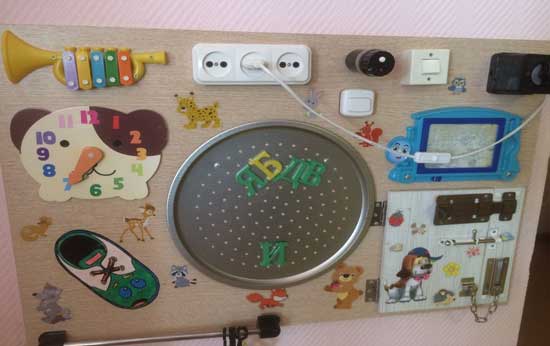
Didactic game “Carnations and Rubber Bands”
This game is aimed at developing fine motor skills in the hands of children of primary preschool age, developing sensory perception, thinking and imagination.
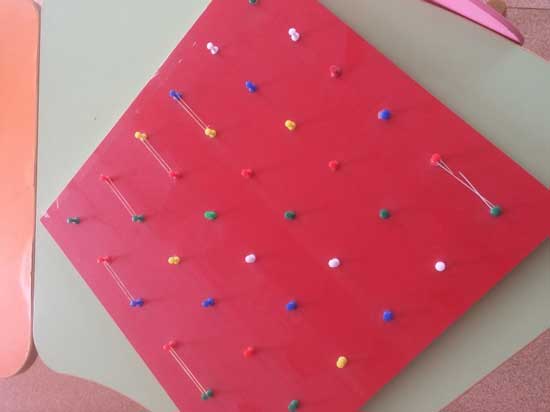
"Development board"
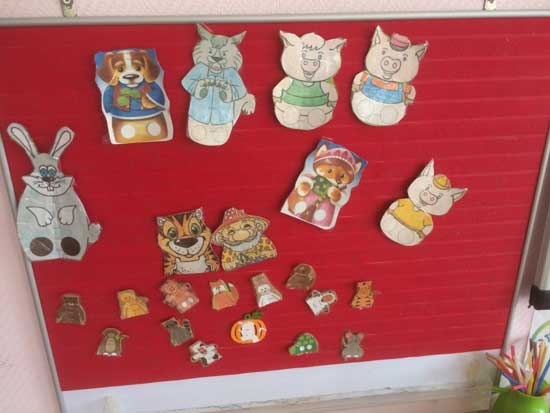
Didactic game " Aquarium ".
The game is designed for children of middle and senior preschool age.
Purpose of the game: Continue to develop the ability to count to 10, using the correct counting techniques: name the numbers in order; relate each numeral to only one object of the group being counted, form ideas about ordinal counting, introduce decorative fish and sea creatures, develop children’s motor skills and sensory skills.
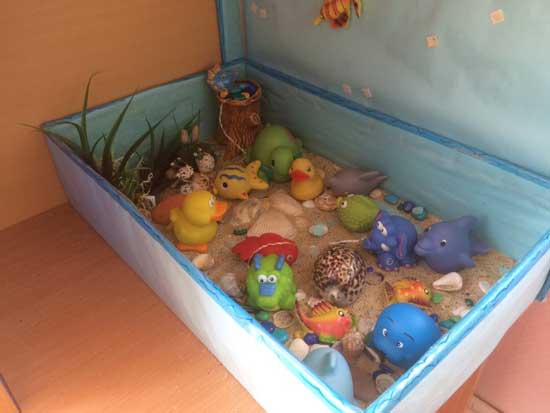
«Experimentation corner."
Labeled containers contain items for testing and experimentation , and can also be used for creativity. They contained: sand, earth, pebbles, river pebbles, tree bark, twigs, mosses, tree seeds, flower and vegetable seeds, balls, pieces of fur, fabric, leather, wire, acorns, cones, chestnuts, shells, balloons ... Several coniferous branches from pine, spruce, thuja, juniper. I sewed several aprons and arm ruffles.

“Theater of a healthy lifestyle” (our assistants are washbasins, toothpickers,
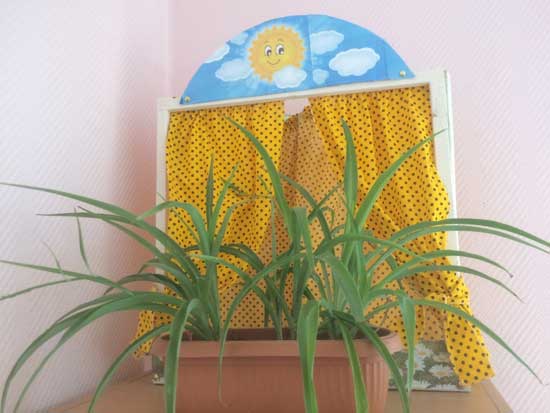
Electronic manuals
What are educational materials in electronic form? These are video lessons, various presentations, electronic audio and video books.
The most effective of all electronic aids are video lessons; by watching such material, most of the information is absorbed. With the help of a video lesson, the student can independently study the topic; this option is convenient if the student is ill or when learning remotely.
Such materials are supplemented with tables, diagrams, photographs, which makes the learning process more fun.
So, when using electronic materials, there is no need for a whole bunch of paper notes and visual aids, but naturally this does not replace them completely.
With distance learning, you have the opportunity to ask questions to the teacher online, complete practical work and submit it for testing.
The presence of electronic materials in the modern world is necessary and plays a huge role in the learning process:
- the efficiency of mastering the material increases;
- searching for information takes less time;
- children are interested in learning the subject;
- You can study the lesson yourself;
- can be used for a large audience;
- it is possible to clearly explain new information.
